Badger burrows
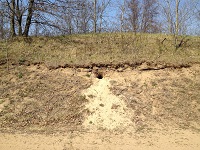
The most conspicuous burrows are those found on exposed banks
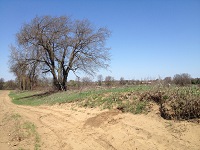
Badger burrows are most often found along habitat edges. When fresh digging is present, they can be easy to spot and identify.
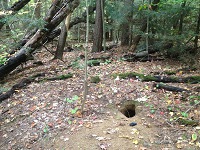
Many badger burrows are found inside the forest edge, especially if there are ravines and gullies nearby.
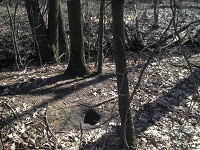
Many old burrows do not require digging each time a badger uses them. Without the fresh digging, identification is more difficult
Burrows are often the best way of determining whether or not a badger lives in an area. A single badger may have hundreds of unique burrows that it, as well as other badgers and other species, may use. In places where badgers live, such as the Norfolk county area, most burrows are actually badger burrows. In fact, many people have seen badger burrows, but they are rarely recognized. Instead they are usually assumed to belong to animals such as fox, groundhog, or even coyote, all of which will use/modify vacant badger burrows as well.
But identification is not always straightforward. Both the physical appearance and location of badger burrows are highly variable. And while some burrows can be distinctive and conspicuous, most are in places where they are not easily spotted, such as ravines, gullies, and in hidden under thorns and brambles.
- Usually found near a habitat edge, such as where a field meets a forest, a hedgerow divides two fields, or next to a ravine
- Generally about 10 inches wide (and not quite as tall) but the size is very variable
- May have claw marks on the inside walls
- When there is fresh digging, they are very distinctive.
- Older burrows may have very little or no digging, making them harder to identify
- Many people have seen badger burrows without realizing it
- Any burrow larger than 8 inches wide has a good chance of having been dug by a badger, and is worth reporting
On this page you'll find examples of a wide variety of different badger burrows. Most of these burrows had a badger inside at the time the picture was taken.
Burrows on Field edges
These are the most likely burrows to be seen due to where they are located. The most conspicuous of these are the ones that occur on slopes or banks, since they are even more visible. But most burrows along field/forest edges are just inside the forest and not as easily spotted)
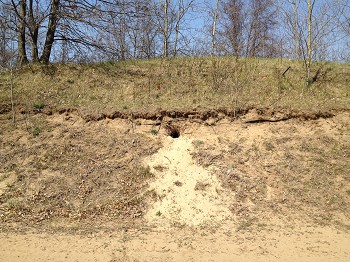
This burrow was very old (possibly even decades) but there was enough fresh digging to make it very distinctive and obvious. An example of a conspicuous and fresh badger burrow on a bank on a field edge
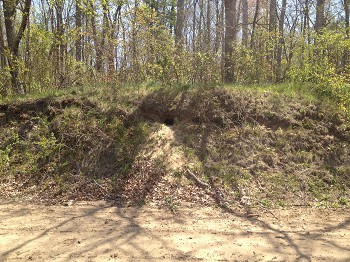
Another badger burrow on a cut next to a field. Many farmers have seen this sort of burrow but assumed it was fox
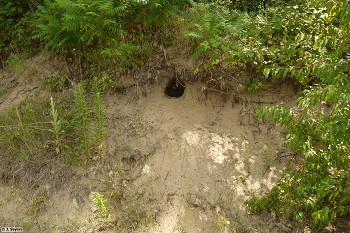
Burrow on a very steep bank. Badger have a surprising ability to scale steep banks, sometimes to dig burrows for shelter, and other times to raid the nests of birds
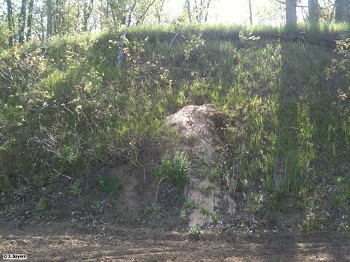
This burrow is a little older and the soil spill is started to get grown over with grass
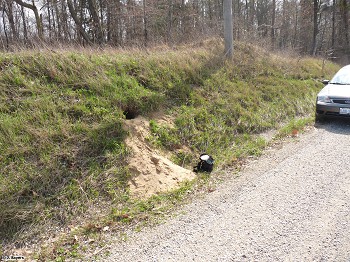
A burrow dug on the side of the road. This was was several weeks old.
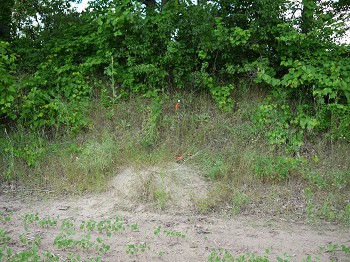
The remains of an old burrow on the side of a field. The evidence of the soil pile is clearly visible even though the burrow itself has caved in
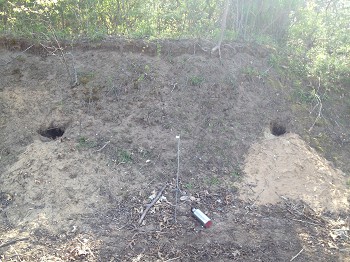
Often burrows on banks occur in multiples, possibly because banks are likely to attract badgers over several generations
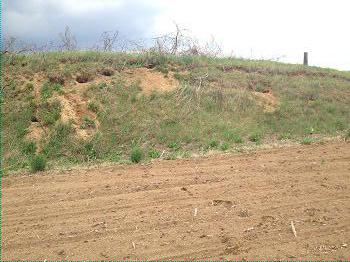
There were well over a dozen burrows of various ages, size, and condition on this slope separating two fields
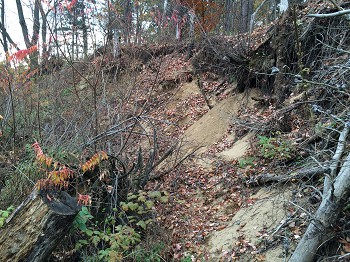
A series of several fresh burrows along an eroded bank next to a field
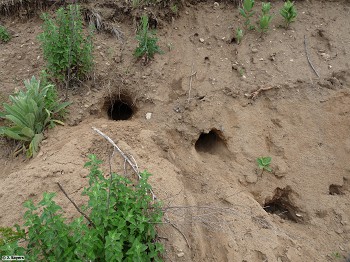
Fresh burrows dug by a female badger and her two kits.
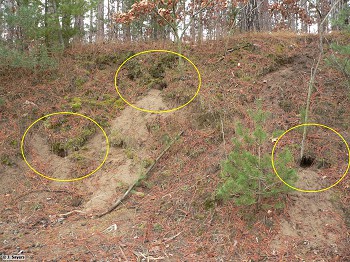
A series of burrows along a bank. These ones are older, and are not quite as conspicuous as fresher burrows
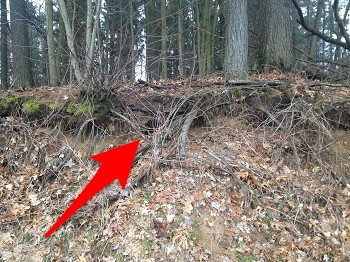
Many badger burrows are hidden underneath roots.
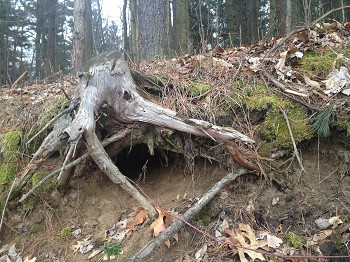
This burrow is beneath an old stump. It was old, lacked any dirt pile, and would not have caught the eye of anyone
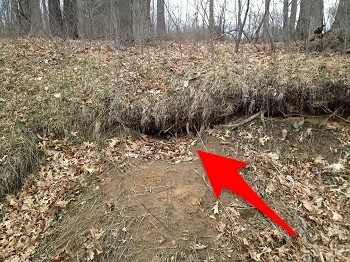
Believe it or not, a badger was found to spend a couple days in an obsure burrow here. There is no fresh digging but you can see the remnants of the old dirt pile
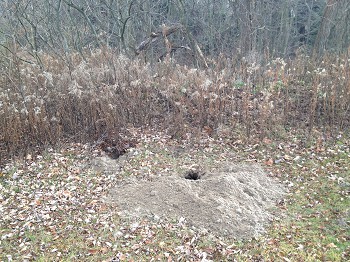
A medium-sized and fresh burrow on the side of the field
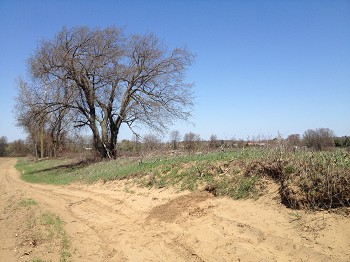
When there is fresh digging, even a rather small burrow can be very easy to spot
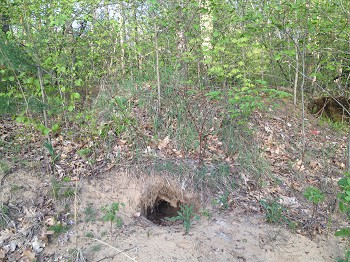
A burrow by the side of an irrigation pond. There was no recent digging but the burrow measured more than a foot across big enough for a badger to enter without digging
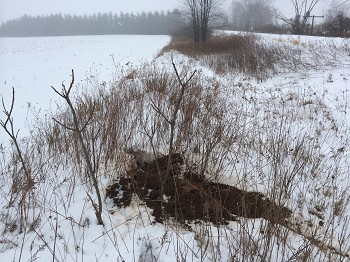
Some fresh digging at an old burrow between a field and a railway
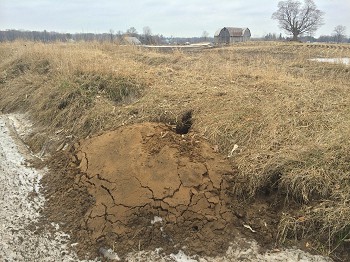
A large dirt pile at a burrow on a bank between a field and a fallow area
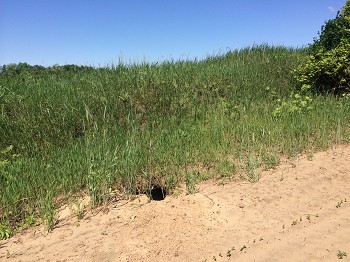
There is a just a little bit of fresh digging here, but the burrow entrance is still quite obvious
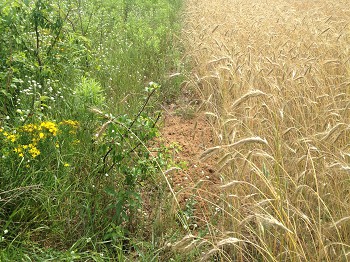
Burrows along field edges are often difficult to spot when the crops and vegetation have grown up. The dirt pile in the picture measured 6 ft across, but would easily be missed by someone walking by
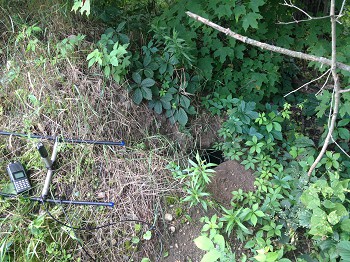
A female badger was in this very small burrow next to a field and ravine
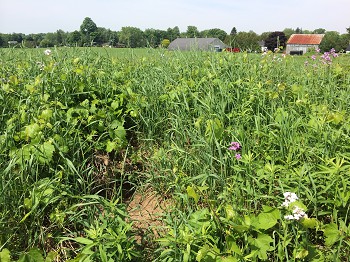
This burrow was on a small weedy knoll separating a field from a fallow area. The burrow itself was small, and there was no dirt pile, making the entire thing very inconspicuous
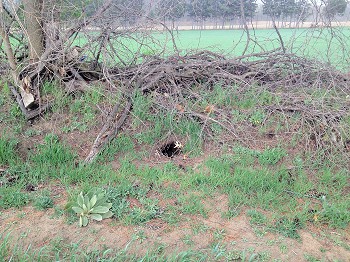
The badger that entered this burrow did not need to do any digging. There is no soil pile and no digging, just the burrow entrance visible.
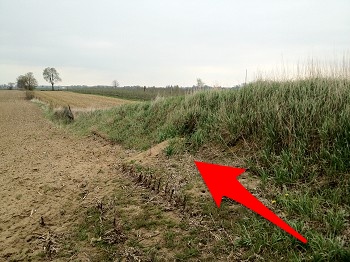
This burrow hasn't been used in several months, but the old dirt pile is still visible
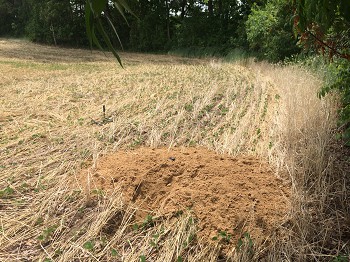
A few of the burrows along field edges occur just inside the field,usually by no more than a few feet.
Forests, ravines, and gullies
A surprising number of burrows occur inside forests. Most of these are close to the edge, but were dug inside the forest rather than on the field edge. But some are deep inside the forest. In almost every case, those who stumble across these burrow assume they are fox burrows. And while foxes sometimes use these burrows, they were originally dug by badgers. A large number of burrows are found at or near a ravine or gully.
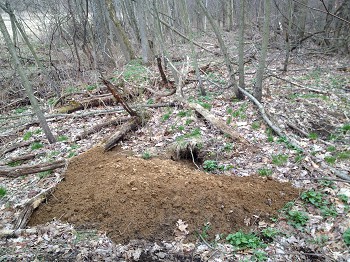
The appearance of the soil pile is typical of a fresh burrow dug on flat ground
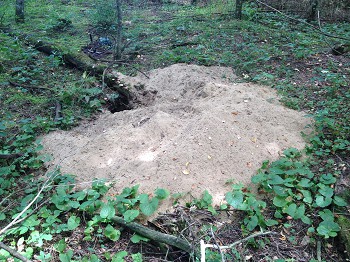
This is a fresh burrow, with a lot of excavated soil. This is very easily identified as badger. As with most burrows in the forest, this is only a few meters from the forest edge
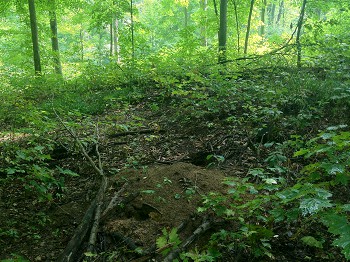
A burrow deep inside the forest. Medium sized, with a an old pile that showed some recent badger digging
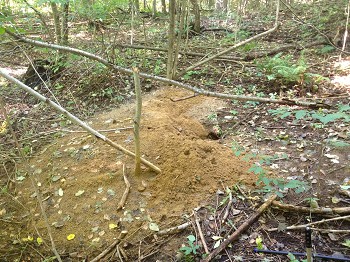
This burrow was likely quite old, and is one that may have been occupied at times by fox as well as badger. The original large pile is visible, as is some fresh digging
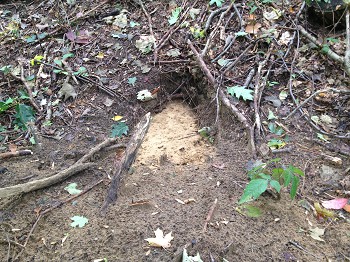
Some old burrows require little digging for a badger to use. The badger inside this burrow only dug enough to "plug" the entrance with soil. Actually this is a commonly observed on burrows that have badgers inside them
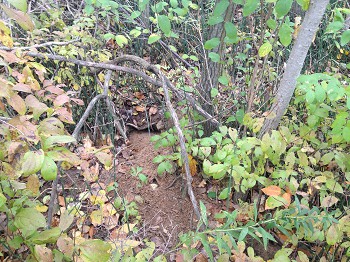
Another burrow that has had the entrance "plugged" with soil from inside.
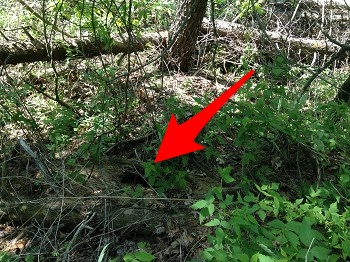
A very small burrow with only a little bit of digging (Click to see the full sized image). A badger was in this burrow
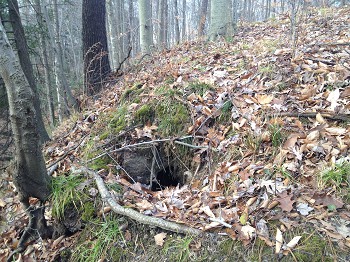
This old burrow on the side of a gully had a male badger in it when this photo was taken. There was no digging from his visit, and only a few leaves were overturned. An old badger burrow on the side of a ravine that hasn't been used for a while
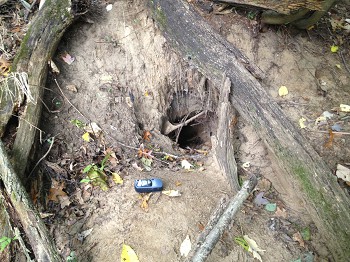
Many of the burrows on ravines, such as this one, are very old. The entrances are often very eroded, and they often require no fresh digging.
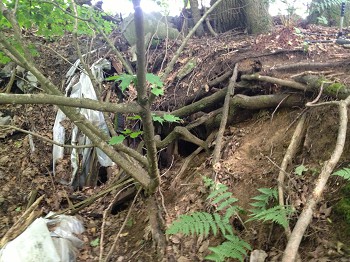
Often, burrows in ravines and gullies are found under the roots of trees. The burrow under these roots could only be seen by peering through the roots, and then only with the help of a flashlight. Another burrow underneath a jumble of roots at the top of a ravine
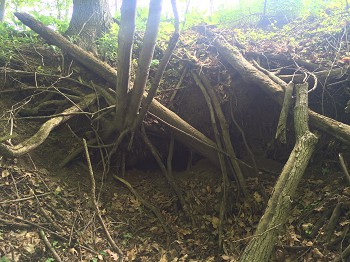
Another burrow underneath roots and stumps at the top of a ravine. The actual burrow entrance is hidden in shadow and there is no obvious dirt pile
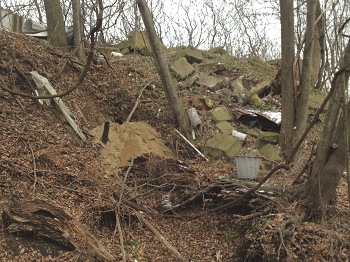
Often, burrows along ravines seem to occur where junk and debris have been dumped over the years
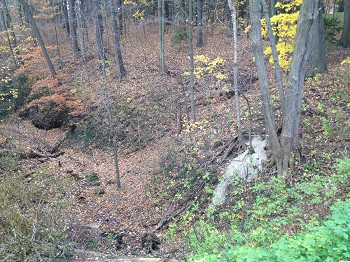
Fresh digging is often the most distinctive and conspicuous feature of a badger burrow. The excavated soil here is clearly visible from the other side of the small gully
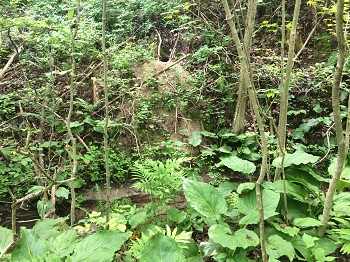
A burrow on the side of a ravine, near the a small creek. Burrows can occasionally be found near wet areas like this if there is dry ground to use
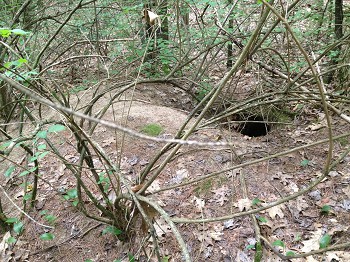
A very old burrow deep inside the forest. It would almost certainly have been considered a fox den by anyone who found it. It's quite likely that other animals have used this burrow as well.
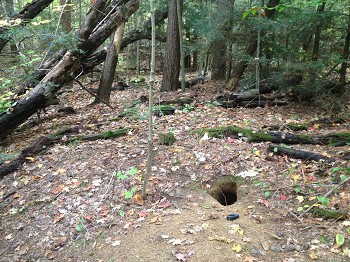
Anyone who came across this burrow would almost certainly think it was a fox den. But in fact it was a badger burrow, and was occupied by one for several weeks during the late fall and winter. It's likely that foxes have also used it.
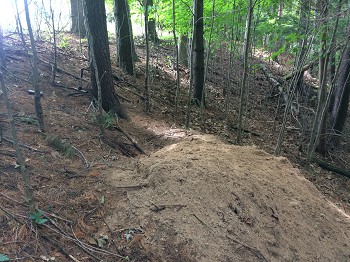
A burrow in the forest with a very large mound. This was only a few meters from the forest edge, and is a very old burrow.
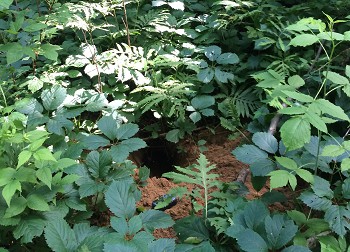
This burrow was only found with the help of the radio-transmitter. Before we arrived, the burrow was completely hidden below the leaves.
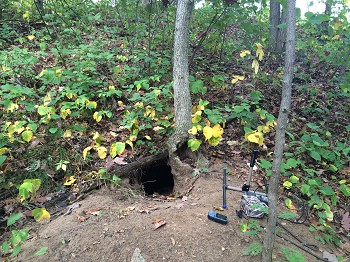
This old burrow had a packed down dirt pile and a very large entrance. It's very likely that foxes have used this burrow in the past as well.
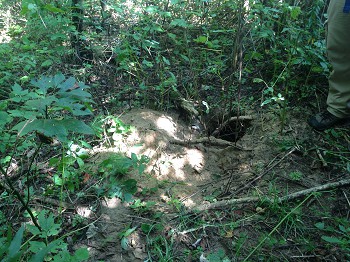
A small and nondescript burrow in the middle of the forest. Note the legs of the man standing next to it. An adult male badger was in this burrow.
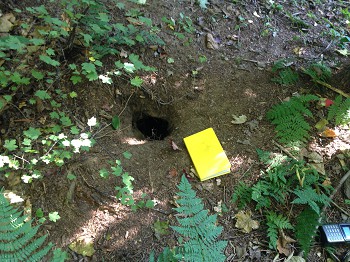
Some burrows are surprisingly small. A female badger was in this burrow and didn't even have to dig to enter it. This burrow was only marginally larger than a groundhog burrow
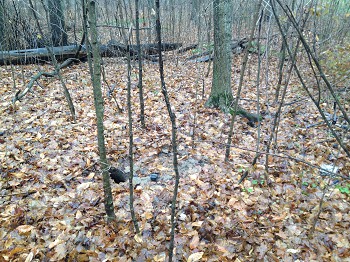
A very small burrow entrance inside a woodlot. There was a very small and old dirt pile that was covered by leaves. A large male badger as inside this burrow
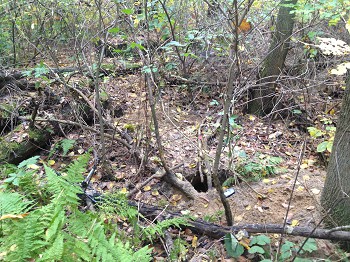
A very inconspicuous burrow in a patch of shrubs. The burrow is old and has the remnants of a small dirt pile, but there is also some fresh digging as well
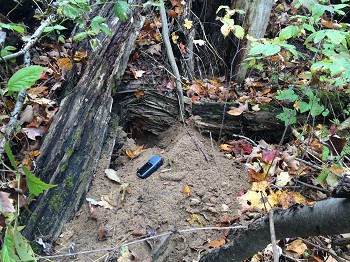
A relatively small burrow just below the remains of an old log. Burrows are often next next to or just below some sort of object like a stump or a log.
Claw marks in burrows
Claw marks can occasionally be used to help identify badger burrows. A badger digs with a "breast-stroke" method (rather than the "doggy-paddle" style of dogs and coyotes). Because of this, their long front claws sometimes, but not always, leave deep scratches on the inside walls of the burrow. Groundhogs leave similar claw marks, but these are considerably smaller.
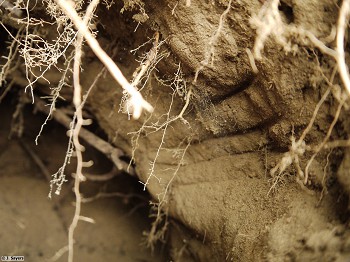
Four distinct claw marks on the inside wall
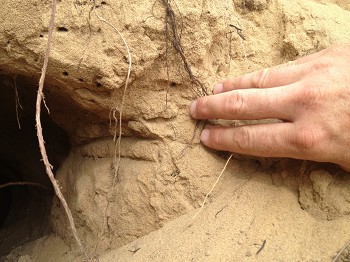
More claw marks, with a hand beside it for scale. A badger's front claws and paw are large for its size
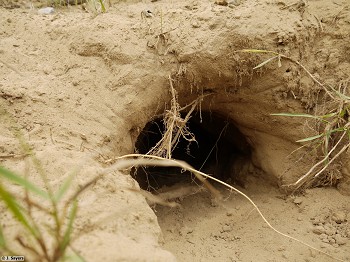
A couple deep scratches can be seen running lengthwise along the wall of this burrow
Badger diggings
In addition to digging burrows for shelter, badger make smaller excavations for hunting or for exploring possible burrow sites. These vary in size and appearance, and are generally not very useful for identification since they can resemble the diggings of other animals
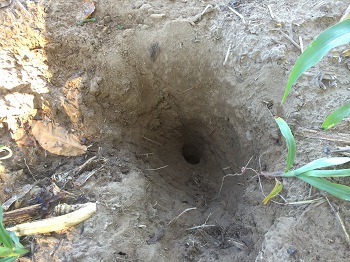
Many of the badger's diggings are for the purpose of hunting other burrowing animals.
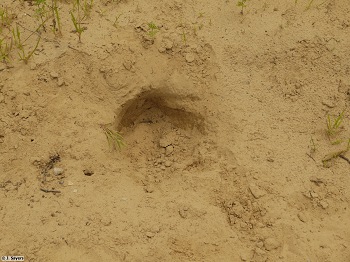
The purpose of many small diggings is unclear. Some of these may be exploratory — looking for good burrow locations or whether prey may be present.
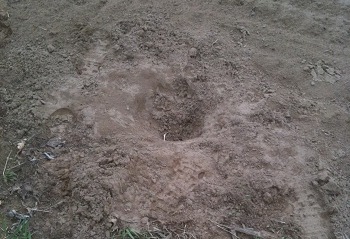
In general, most badger diggings lack sufficient distinctive features for confident identification.
Burrows in strange places
Nothing highlights the variability in the appearance and location of badger burrows than some of the very unlikely places they can show up.
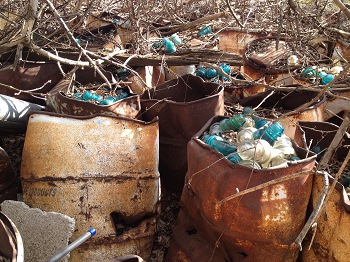
A badger spent one day in this pile of old drums rather than vist a "proper" burrow.
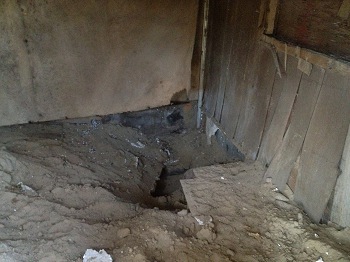
A badger dug a burrow inside a small, dilapidated out-buildling, and spent several days there.
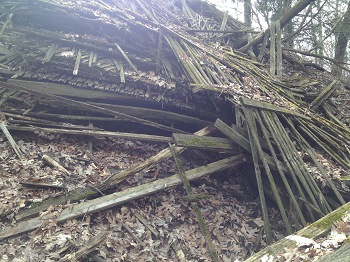
Sometimes badgers don't actually dig proper burrows, but will hunker down for the day under some other objects, like this scrap lumber.
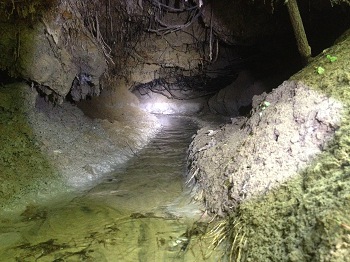
A badger travelled up this cave-like spring/creek to spend the day.
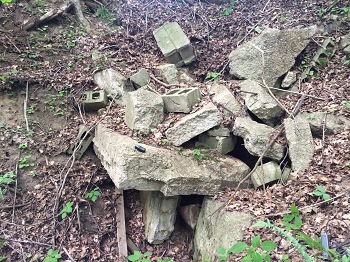
A badger was located here, hidden between the slabs of concrete.
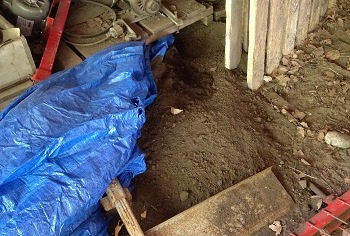
This burrow was found inside a dirt-floor barn. The badger was only there for one day before moving on.
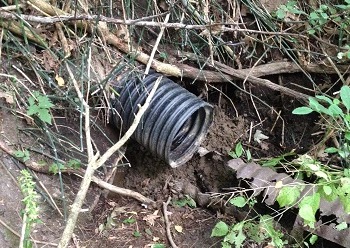
Rather than dig its own burrow, a badger decided to crawl up the tile drain instead. We've heard reports of badgers dying in these.
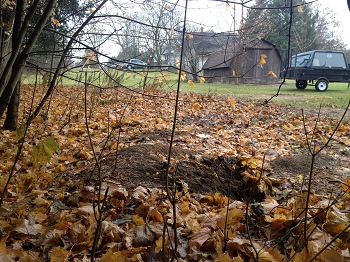
Despite preferring to live far from humans, badgers will occasionally come quite close to buildings at night
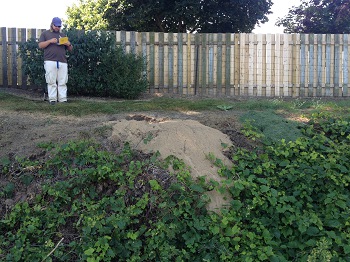
Some badgers actually have a surprising number of their burrows inside small towns. But since they are active mostly at night, few people are aware of it
































